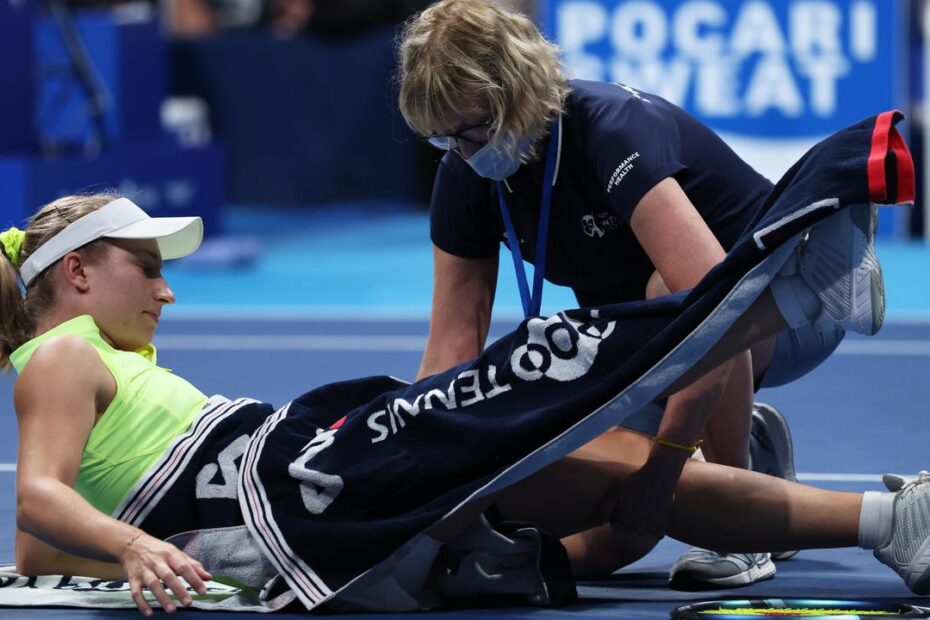Tennis, a sport celebrated for its intensity and agility, demands a proactive approach to injury prevention and recovery. In this extensive guide, we’ll delve into the nuances of tennis injuries, preventive measures, and recovery strategies. Whether you’re a casual player or aspiring pro, the insights here are tailored to elevate your game and safeguard against common pitfalls.
Common Tennis Injuries and Prevention Strategies
Tennis Elbow
Tennis elbow, or lateral epicondylitis, is a prevalent injury among players. To prevent this overuse injury, incorporate forearm strengthening exercises such as wrist curls and reverse wrist curls into your routine. Ensure proper racket grip size and technique and consider using an elbow brace for added support during play.
Sprains and Strains
Sprained ankles and muscle strains often result from sudden movements on the court. To mitigate these risks, focus on dynamic warm-up exercises, including ankle circles, leg swings, and lateral shuffles. Strengthening the muscles around joints through exercises like calf raises and lunges can enhance stability.
Shoulder Injuries
Tennis places significant strain on the shoulders, leading to injuries like rotator cuff tears. Incorporate shoulder-specific exercises like external rotations and shoulder presses into your strength training regimen. Additionally, maintain proper serving and hitting techniques to reduce stress on the shoulder joints.
Stress Fractures
Repetitive impact on the lower body can lead to stress fractures, especially in the feet and shins. To prevent this, invest in supportive footwear, vary your training surfaces, and include weight-bearing exercises like jumping jacks and skipping in your conditioning routine.
Tailored Warm-Up Exercises for Tennis Players
A proper warm-up is vital for preparing the body for the rigours of tennis. Tailor your warm-up routine to include dynamic stretches and movements specific to the demands of the sport:
- Joint Mobility Exercises: Begin with gentle joint rotations for the ankles, knees, hips, shoulders, and wrists.
- Cardiovascular Warm-Up: Engage in light jogging or skipping to increase heart rate and blood flow to the muscles.
- Dynamic Stretches: Incorporate dynamic stretches such as leg swings, arm circles, and torso twists to improve flexibility and range of motion.
- Sport-Specific Drills: Include tennis-specific movements like lateral shuffles, quick sprints, and agility drills to mimic on-court actions.
The Importance of Cross-Training in Injury Prevention
Cross-training plays a pivotal role in preventing injuries by enhancing overall fitness, addressing muscle imbalances, and reducing repetitive stress on specific body parts. Consider incorporating activities like swimming, cycling, or yoga into your training regimen to promote a well-rounded athleticism that complements your tennis game.
Strengthening Exercises for Enhanced Performance
To elevate your tennis performance and safeguard against injuries, focus on targeted strength training exercises:
- Core Strengthening: A strong core improves stability and power during shots. Include exercises like planks, Russian twists, and bicycle crunches.
- Leg Strengthening: Develop strength in your lower body with squats, lunges, and calf raises to enhance agility and speed on the court.
- Rotational Exercises: Improve your ability to generate power in your shots with rotational exercises like medicine ball twists and cable woodchoppers.
- Balance Training: Enhance proprioception and balance with exercises like single-leg stands and stability ball exercises.
Best Practices for Recovering from Tennis-Related Injuries
Injuries are an inevitable part of any sport, but proper recovery is key to a swift return to the court. Follow these best practices:
- I.C.E Method: Rest, ice, compression, and elevation are fundamental for acute injury management. Apply these principles immediately after an injury to reduce inflammation and promote healing.
- Professional Guidance: Consult with a sports medicine professional or physical therapist for personalized rehabilitation programs tailored to your injury.
- Gradual Return to Play: Resist the urge to rush back onto the court. Gradually reintroduce activities and monitor your body’s response to avoid setbacks.
- Cross-Training During Recovery: Engage in low-impact cross-training activities during the recovery phase to maintain overall fitness without exacerbating the injury.
Recommended Rest Periods and Overuse Injury Prevention
Intense training sessions can lead to overuse injuries if not managed carefully. To prevent burnout and overuse injuries like tennis elbow, incorporate rest periods into your training schedule. Listen to your body, and if you experience persistent discomfort, consider adjusting your training intensity or duration.
Nutrition’s Role in Injury Prevention and Recovery
Proper nutrition is a cornerstone of injury prevention and recovery. Ensure an adequate intake of:
- Protein: Essential for muscle repair and recovery.
- Hydration: Maintain optimal fluid balance to support joint function and overall performance.
- Anti-Inflammatory Foods: Include foods rich in omega-3 fatty acids, antioxidants, and vitamin C to reduce inflammation.
Surface-Specific Injury Prevention Strategies
Different tennis court surfaces pose varied challenges to players. Adjust your game and injury prevention strategies accordingly:
- Clay Courts: Place less strain on joints but may lead to slips. Focus on lateral stability exercises and traction-enhancing footwear.
- Hard Courts: Increase the risk of impact-related injuries. Invest in shock-absorbing footwear and prioritize lower body strengthening exercises.
- Grass Courts: Pose a lower risk of impact injuries but may lead to slips. Emphasize agility drills and proper footing.
Comprehensive Warm-Up and Cool-Down Routine
A thorough warm-up and cool-down routine is your armour against injuries. Follow this comprehensive routine:
Warm-Up:
- Joint Mobility Exercises (5 minutes): Gentle rotations for all major joints.
- Cardiovascular Warm-Up (10 minutes): Light jogging, skipping, or jumping jacks.
- Dynamic Stretches (8-10 minutes): Leg swings, arm circles, torso twists.
- Sport-Specific Drills (10 minutes): Lateral shuffles, sprints, agility drills.
Cool-Down:
- Static Stretching (10 minutes): Focus on major muscle groups, holding each stretch for 15-30 seconds.
- Foam Rolling (5 minutes): Address tightness and release tension in muscles.
- Hydration (ongoing): Replenish fluids lost during play.
- Reflect and Plan (5 minutes): Evaluate your performance, note any discomfort, and plan adjustments for future sessions.
Conclusion
In conclusion, injury prevention and recovery for tennis players require a multifaceted approach. By incorporating targeted exercises, adopting proper warm-up and cool-down routines, and embracing cross-training, players can enjoy a sustained and successful tennis journey. Remember, a proactive approach to injury management is not only beneficial for immediate performance but also crucial for the longevity of your tennis career. Keep playing, stay healthy, and enjoy the game!
Frequently Asked Questions
What are the most common injuries in tennis, and how can they be prevented?
Common tennis injuries include tennis elbow, sprains, strains, shoulder injuries, and stress fractures. Prevention involves specific exercises, proper technique, suitable equipment, and surface-aware training.
Are there specific warm-up exercises tailored for tennis players to reduce injury risk?
Yes, a tailored warm-up is essential. It includes joint mobility exercises, cardiovascular warm-up, dynamic stretches, and sport-specific drills to prepare the body for the demands of tennis.
How important is cross-training for injury prevention in tennis?
Cross-training is crucial. It enhances overall fitness, balances muscle development, and reduces repetitive stress. Activities like swimming, cycling, or yoga complement tennis training, reducing the risk of injuries.
Can you suggest specific strengthening exercises to improve tennis performance and prevent injuries?
Certainly. Core strengthening (planks, Russian twists), leg exercises (squats, lunges), rotational exercises (medicine ball twists), and balance training (single-leg stands) enhance performance and reduce injury risks.
What are the best practices for recovering from a tennis-related injury?
Best practices include following the R.I.C.E method (Rest, Ice, Compression, Elevation), seeking professional guidance, gradually returning to play, and engaging in low-impact cross-training during recovery.
Are there recommended rest periods for tennis players during intense training sessions to avoid overuse injuries?
Yes, incorporating rest days into your training schedule is crucial. Listening to your body, adjusting training intensity, and varying your routine help prevent overuse injuries.
How can players protect themselves from common overuse injuries like tennis elbow?
Prevention involves forearm strengthening exercises, maintaining proper technique, and using supportive equipment like elbow braces. Rest periods and avoiding overexertion are also key.
What role does proper nutrition play in injury prevention and recovery for tennis players?
Proper nutrition is essential. Adequate protein for muscle repair, hydration for joint function, and anti-inflammatory foods (omega-3 fatty acids, antioxidants) contribute to injury prevention and recovery.
Are there specific techniques or strategies for preventing and managing injuries on different tennis court surfaces?
Yes. Strategies vary for clay, hard, and grass courts. For instance, clay court players may focus on lateral stability, hard court players on shock absorption






